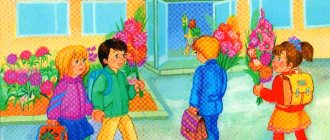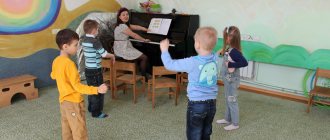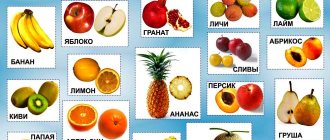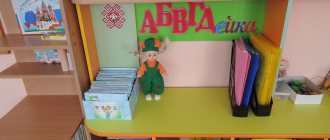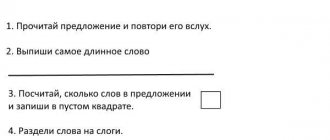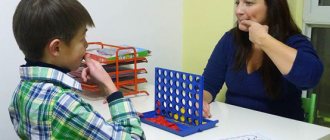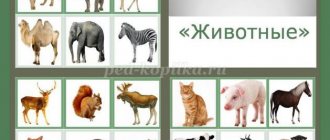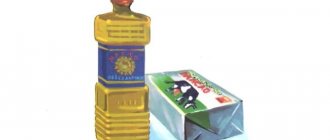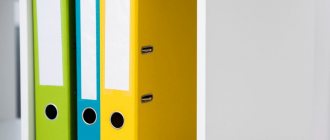- home
- Speech development
The topic “Toys” must be used during speech therapy classes with preschoolers aged 2-7 years.
Of course, the best pictures for children in kindergarten are Toys, which are specially selected for educational activities. In the lexical material on this topic, several important “steps” can be identified, elements that must be mastered by preschoolers:
- The very generalizing concept of “toys”.
- Various names of items used for different types of games (story-based, action, etc.).
- General features and properties of toys, as well as their differences from other items.
- Ways to use certain toys.
- Features of their device.
- An idea of the material from which game items are made.
Here is a minimum list of words on the topic of toys for children that should be introduced into the active vocabulary of preschool children:
- Names of toys and their parts (nouns):
bear, bunny, dog, doll, car, ball, top, construction set, matryoshka, pyramid, head, torso, arm, leg, muzzle, paw, tail.
- Characteristics of items for games (adjectives):
* it is useful to teach them with children in pairs, comparing the properties of different toys.
Big - small, round - square, soft - hard, smooth - rough, fur - plastic, iron - wood, new - old.
- Various actions that can be performed with these objects (verbs):
Roll, carry, build, swing, dress, bathe, feed, wear, buy, lose, find, sew, play, collect.
Drawn pictures
For the formation of a passive vocabulary, pictures for children depicting various toys are of great importance. It is very good if they are presented in a wide variety, this allows you to offer the child many different speech exercises and activities.
For speech therapy games, it is much more convenient to use cards rather than real objects. Sorting and describing images not only contributes to children’s speech development, but also improves them:
- visual-figurative thinking;
- RAM;
- attention.
Of course, it is very difficult to draw such pictures yourself; it is better to find ready-made ones selected by professional speech therapists.
Class
Subject. Development of coherent speech
Goal: learning to retell; expansion and activation of vocabulary; formation of an internal retelling plan; development of attention, memory, logical thinking.
Equipment:
magnetic board (composition board); subject picture “Summer” and subject pictures: Masha, house, flowerbed, chickens, rooster, cow, kitten; card with exclamation mark.
Note. Teachers should supplement the set of pictures with a card with an exclamation mark, which will indicate sentences reflecting the assessment of events and attitude to what is happening. For example: Masha likes to relax with her grandmother. “What a beautiful fish.” - thought Masha. Goodbye! and so on.
Progress of the lesson
The teacher attached pictures from top to bottom, one under the other, to a magnetic board (typesetting board), and read the text:
- The long-awaited summer has come. Masha went to visit her grandmother in the village. Grandma has a big beautiful house. Under the windows there is a flower bed with flowers. Variegated chickens roam around the yard. An important rooster is watching over them. The cow Zorka moos for a long time. A small gray kitten yawns and squints on the porch. Masha likes to relax with her grandmother.
Pointing to each picture in turn, the teacher asks the children to remember what was said in each sentence. Then the children retell the entire text in a chain. At the end of the retelling, the teacher turns the pictures over one by one and invites one of the children to reproduce the content of the story.
This arrangement of pictures is explained by the fact that at subsequent stages not only object pictures (denotations) are used, but also graphic schemes of sentences.
Note. If difficulties arise, the child can turn the picture over and, using visual support, restore the content of the sentence.
After a successful retelling, you can turn all the pictures over. The number of cards on the board will correspond to the number of sentences in the text.
Note. Please note that the texts will contain sentences with homogeneous members. In this case, two pictures can be located in one row. And the number of sentences in the text will correspond to the number of rows of pictures. At the end of the lesson or the next day, a more complex type of work is carried out. Pictures for the story are displayed in free order on the board. The teacher reads the text and after reading asks one of the children to arrange the pictures in the desired sequence. All children help and monitor the correctness of the task. After which you can repeat the retelling of the entire text again.
Coloring pages
To conduct classes on the topic “Toys” it is also very useful to use thematic coloring books. They help the child not only learn and remember all kinds of names of objects for games, but also practice using a large number of descriptive adjectives (in descriptions of various colors and materials). A correctly selected coloring book is a real helper for speech therapists and parents!
The use of subject pictures and plot pictures in the development of coherent speech in children
Zemtsova Ekaterina
The use of subject pictures and plot pictures in the development of coherent speech in children
«The use of subject pictures and plot pictures in the development of coherent speech in children»
The first three years of life are a period of intensive physical and psychological development of children . Guided by the education program in kindergarten, we form in children correct elementary ideas and concepts about the surrounding reality, develop speech , contribute to the formation of positive character traits and the development of moral and aesthetic feelings.
Children become familiar with the life around them mainly through direct communication with adults, observation of objects , and various activities in everyday life, in games and in class. For children to develop correct ideas , pictures are also of great importance . We believe that they help clarify and consolidate the knowledge acquired in the process of direct acquaintance with the surrounding life, and develop the language and thinking of children . Looking at pictures evokes certain feelings and emotions in a child , promotes the formation of love for loved ones - mother, father, grandmother, and respect for the work of adults. During classes we show object pictures - these are images of animals, plants, toys and various household items . The pictures show objects of different sizes (big bunny, small, colors (tower red, blue, in various actions: sleeping, eating, sitting (cat, singing, pecking (rooster, roaring, grazing (cow))
etc. To teach
children to pronounce accessible sound combinations and words, we show pictures and images of animals (a dog barks, a cow roars, a duck quacks, etc.)
.
The series of story pictures includes pictures with simple and more complex content.
Pictures with simple content are images of people who are acting (a girl washes herself, plays with a doll, washes dishes, a grandmother sews, a mother does laundry, a mother dresses her daughter).
Pictures with a more complex plot depict several objects in various interactions and relationships (mother and daughter on a walk, children congratulating grandfather on the holiday, children in the forest). This series also includes those pictures that depict the work of children and adults (children planting, watering flowers, dad driving a harvester)
.
When working with children of our age (early age), we use subject pictures and story pictures . Some of them are shown in class, others are given for viewing in free time. We select them depending on the program objectives, age and level of development of the children
Games
With “Toys” pictures you can conduct many simple and effective speech therapy activities aimed at developing the speech of preschool children. Here are some examples of such games:
Name the pictures
The development of children's speech is facilitated by naming the various toys depicted on the cards. It is important to choose the most realistic drawings, this helps the child quickly recognize this or that object. Such pictures of toys for children must certainly be bright and attractive in appearance.
What's missing here?
The popular logic game “Odd Four” can also be used in speech therapy classes. During it, children are offered four images, three of which can be called in one word (“toys”), and one cannot; this card is selected from other categories (vegetables, plants, animals, transport, etc.). This game helps to enrich and activate passive vocabulary, and also perfectly trains the attention and thinking of preschoolers.
Which? Which? Which?
Show your child one picture at a time from the set of “Toys” cards and ask him to list the properties of the object depicted on it. For example: a doll - new, elegant, plastic, curly, blue-eyed, big, new, etc. If you have pictures from the Toys for Children series on a transparent background, then it is better to use them in this game.
Call me kindly
This game is great for developing the skill of using diminutive suffixes on nouns. An adult shows children 4 years and older toys (in pictures or real ones) and asks them to name them affectionately. Examples:
- doll - doll; - ball - ball; - bear - bear; - elephant - elephant; - hare - bunny; - car - machine; - jump rope - jump rope.
For children of senior preschool age 6-7 years old, you can conduct a complicated lesson: ask them to remember the names of toys that are used only in an “affectionate” form. (top, pyramid) or do not have it at all (spinning top, hoop, train, clown, etc.).
One-many
Teach your child not only to name toys one by one, but also to find one or another of them in a group of similar/identical images. Example:
ball - ball doll - dolls cube - cubes ball - balls.
Detectives
Another simple and exciting game that will help your child quickly learn the names of a large number of toys. As visual material for it you can use:
- Pictures;
- real objects for games;
- video materials.
First you need to show four different pictures with images of toys, and then hide (close) one of the cards. The baby must remember and name what is missing.
Guess what color
Invite your child to name the color of the toy you show him. You need to start with basic colors, then you can add more complex options, with shades (bright red, scarlet, dark green, light pink). During this game you can also reinforce the concepts
- bright; – multi-colored; - transparent; – multi-color.
Whose toy is this?
This exercise allows you to teach a preschool child how to coordinate nouns (names of toys) with personal pronouns. You show your child a picture and ask: “Whose is this?” Possible answers:
my (dog, spinning top, pyramid) my (ball, elephant, bunny, clown) my (lotto, dominoes) my (cubes, balls)
Who's doing what?
This game allows you to train the skill of agreeing a noun with a verb. Show your child pictures of toys (singular and plural, pairs) one at a time and ask the question: “What is this? What is he doing? Possible answers:
the doll is sleeping - the dolls are sleeping the parsley is sitting - the parsleys are sitting the bunny fell from the shelf - the bunnies fell from the shelf the top is spinning - the tops are spinning the ball rolled away - the balls rolled away the car broke down - the cars broke down the bear is sleeping - the bears are sleeping
The large picture “Toys for Children” can be used for a similar activity with several kids at once, in a group or subgroup.
What toy?
This fun game helps children learn the rules of noun-adjective agreement quickly and easily. Ask your child to come up with as many characteristics as possible for the toy whose image is in your hands. It is best to play this game among several children or in an adult-child pair. Try to avoid repeating adjectives; it is important to name as many different words as possible.
Example:
The horse is wooden, new, beloved, comfortable, hard, smooth, brown. Elephant - purple, soft, big, sad, big-eared.
Shop
The usual game of “shopping” can be slightly modified and effectively used to develop the speech of children in the senior and preparatory groups of kindergarten. Invite the children to choose a card from the “Toys” set, i.e., “make a purchase.” Then the boy or girl goes to the window and chooses a “purchase”. The child must accompany his actions with a correctly constructed complete sentence, in which he must name the selected object and several of its characteristics (color, material, size and other features). This exercise helps enrich children's active vocabulary and develop their imagination.
Example:
1. I want to buy a big yellow ball. 2. I want to buy a bright red cube. 3. I want to buy an elegant little doll. 4. I want to buy a set of wooden blocks in a box.
The picture Toys for Children on a transparent background is very suitable for this game, although ordinary cardboard cards can also be used.
Subject development environment for sound and intonation culture of speech
Subject-based development environment for the development of sound and intonation culture of speech, phonemic hearing in accordance with the Federal State Educational Standard for Educational Education
(message from teacher D.S. Ibadova)
In accordance with the requirements of the Federal State Educational Standard for Educational Education for a subject-development environment, it is important to create conditions in a preschool educational institution that evoke feelings of emotional comfort and psychological security in children. For this, the following are important: the quality of speech of the teacher of a preschool educational institution, the quality of the linguistic design of speech, the value and personal attitudes of the teacher, communicative competence, a clear selection of information to create a statement, focus on the process of direct communication and the subject-development environment in which speech development is carried out.
A speech development environment is a specially organized environment that most effectively influences the development of various aspects of each child’s speech.
The purpose of building a speech development environment is to saturate the environment with components that ensure the development of the child’s speech.
Tasks:
— provide the opportunity for research and experimentation in the language system;
- provide the opportunity to perceive and observe correct speech;
- provide the opportunity for independent individual speech activity of the child;
— ensure the child’s comfortable state in the manifestation of speech reactions.
The content of the speech development environment is determined by the priority line of speech development of children of each age.
Speech development includes several areas:
- education of sound culture - the formation of the correct pronunciation of sounds by developing the perception of the sounds of native speech and pronunciation;
-development of coherent speech – development of dialogic (conversational) and monological (storytelling) speech in preschool children;
-formation of an elementary awareness of the phenomena of language and speech - the formation of the creative nature of speech, the disclosure to children of various phenomena and relationships in the field of vocabulary in preparation for learning to read and write;
-formation of grammatical structure. In the process of forming the grammatical structure of speech, preschoolers develop the ability to operate with lexical units, ensuring the choice of linguistic means for communication;
- fostering love and interest in the artistic word. The basis of this direction is instilling the skills to listen, hear and perceive literary texts, learning to combine listening with other types of activities, developing the ability to see the image behind the text and speech transmission in conversation;
-development of vocabulary. This area of work is associated with mastering the meanings of words and their appropriate use in accordance with the context of the statement, with the situation directly in which communication takes place.
To realize the goals, objectives and directions of speech development of preschool children in each group, it is necessary to create a speech corner in accordance with the age category of the children.
What should a speech corner contain?
— equipment and filling of the speech zone necessary to consolidate correct speech exhalation: “Leaves”; "Butterflies"; "Magic fluff"; labyrinths; multi-colored balls; sultans; paper snowflakes; pinwheels; foil bells on a string “Storm in a glass”; “Whose boat will get there faster”; “Put the ball into the goal”, etc.;
— for the formation of phonemic perception and hearing: noise instruments; sound boxes; children's musical instruments: piano, accordion, drums, pipe, tambourine, rattle, bells, rattles; subject, plot pictures for pronunciation of sounds and their automation; games with paired cards (sounds: R, L; S, 3, C; Sh, Zh, Shch); sounds of vowels and consonants (houses for hard and soft sounds); individual aids for sound-letter analysis; word schemes; sound tracks, sound ladder; albums on the syllabic structure of the word “Collect a bouquet”; “We divide words into syllables”; "Find yourself a partner"; “Find what sounds”; “Guess where the sound is coming from”; “Lay out the pictures”; “Repeat - don’t make a mistake”; "Quiet - loud"; "General sound"; “Come up with words with sound”; "Broken phone"; “Sound symbols”, etc.;
- for the development of articulatory motor skills: object pictures-supports; articulation patterns; articulatory gymnastics in albums for a specific sound; diagram of the characteristics of sound articulation; articulatory gymnastics in poetry and pictures; forms of articulatory gymnastics for lips and tongue in symbols; albums with articulatory gymnastics; a diagram for characterizing sound in accordance with the age of the pupils;
- to consolidate the skills of correct sound pronunciation of given sounds (in isolation, in syllables, words, in sentences, in coherent speech). Small toys; subject pictures; story pictures; various types of theaters; albums for every sound; speech therapy albums for automating various sounds, tongue twisters, poems, nursery rhymes, tongue twisters; word scheme; mirrors; lotto for sounds C, 3; F, W; R, L; "Fun Gymnastics";
— to consolidate the skills acquired in literacy classes: magnetic board; sets of magnetic letters; boxes of letters and syllables; symbols for sound-letter analysis, cubes “ABC in pictures”, “Learn to read”, “Smart cubes”, “Syllable cubes”, etc.; album “Learning Letters”; manual “Talking ABC”; magic house “ABC book” by N. S. Zhukov, “Reading by syllables”, “Reading with hints”; "Texts with tails"; baby books; “Name, read, check”; "Learn to read"; “I am learning letters”; "Find the letter"; “Are you ready for school?”; "Syllable Lotto"; "Magic Braid"; “Find the place of the sound in the word”; “Read by first sounds”; “Syllabic piggy bank”, etc.; “Smart Games” series, puzzles;
- to activate the dictionary, generalizing concepts and lexical and grammatical categories: subject pictures on lexical topics; “Big and small” (used in a diminutive form); “What is made of what”; "Weather forecast"; "Dress the doll"; "In the animal world"; "Children's computer" and others;
— for the development of coherent speech: a series of plot pictures “Stories in Pictures”; different types of theater; poetry; nursery rhymes; tongue twisters, etc.;
— for the development of fine motor skills: massage rollers, balls, clothespins, stencils; finger games; “The world of your fantasies” (various materials for composing letters); shading games; “Drawing by cells”; mosaics; lacing games, etc.
Requirements for the speech corner:
— didactic equipment must correspond to the structure of children’s speech disorders, their individual and age characteristics;
- visual, didactic material in the speech corner changes according to the lexical topic;
— it is advisable to place the speech corner next to the book corner;
- the design of the corner should be aesthetic, attractive for children, and evoke a desire for independent activity;
— game material must be accessible to the child;
- Do not overload the corner with equipment.
At the end of my speech, I offer you reminders that will help you in your work with students.
1st junior group
— equipment and filling of the speech zone necessary to strengthen correct speech exhalation: “Leaves”; "Butterflies"; "Magic fluff"; labyrinths; multi-colored balls; sultans; paper snowflakes; pinwheels; foil bells on a string “Storm in a glass”; “Whose boat will get there faster”; “Put the ball into the goal”, etc.;
— for the formation of phonemic perception and hearing: noise instruments; sound boxes; children's musical instruments: piano, accordion, drums, pipe, tambourine, rattle, bells, rattles; subject, plot pictures for pronunciation of sounds and their automation; games" "Find what sounds"; “Guess where the sound is coming from”;
- for the development of articulatory motor skills: object pictures-supports; articulation patterns; articulatory gymnastics in albums for a specific sound; diagram of the characteristics of sound articulation; articulatory gymnastics in poetry and pictures; forms of articulatory gymnastics for lips and tongue in symbols; albums with articulatory gymnastics; a diagram for characterizing sound in accordance with the age of the pupils;
- to activate the dictionary, generalizing concepts and lexical and grammatical categories: subject pictures on lexical topics; “Big and small” (used in a diminutive form); “What is made of what”; "Weather forecast"; "Dress the doll"; "In the animal world"; "Children's computer" and others;
- for the development of coherent speech: a series of plot pictures “Stories in Pictures”; different types of theater; poetry; nursery rhymes; tongue twisters, etc.;
— for the development of fine motor skills: massage rollers, balls, clothespins, stencils; finger games; mosaics; lacing games, etc.
2nd junior group
— equipment and filling of the speech zone necessary to strengthen correct speech exhalation: “Leaves”; "Butterflies"; "Magic fluff"; labyrinths; multi-colored balls; sultans; paper snowflakes; pinwheels; foil bells on a string “Storm in a glass”; “Whose boat will get there faster”; “Put the ball into the goal”, etc.;
— for the formation of phonemic perception and hearing: noise instruments; sound boxes; children's musical instruments: piano, accordion, drums, pipe, tambourine, rattle, bells, rattles; subject, plot pictures for pronunciation of sounds and their automation;
games" "Find what sounds"; “Guess where the sound is coming from”;
- for the development of articulatory motor skills: object pictures-supports; articulation patterns; articulatory gymnastics in albums for a specific sound; diagram of the characteristics of sound articulation; articulatory gymnastics in poetry and pictures; forms of articulatory gymnastics for lips and tongue in symbols; albums with articulatory gymnastics; a diagram for characterizing sound in accordance with the age of the pupils;
- to activate the dictionary, generalizing concepts and lexical and grammatical categories: subject pictures on lexical topics; “Big and small” (used in a diminutive form); “What is made of what”; "Weather forecast"; "Dress the doll"; "In the animal world"; "Children's computer" and others;
- for the development of coherent speech: a series of plot pictures “Stories in Pictures”; different types of theater; poetry; nursery rhymes; tongue twisters, etc.;
— for the development of fine motor skills: massage rollers, balls, clothespins, stencils; finger games; mosaics; lacing games, etc.
Middle group
— equipment and filling of the speech zone necessary to strengthen correct speech exhalation: “Leaves”; "Butterflies"; "Magic fluff"; labyrinths; multi-colored balls; sultans; paper snowflakes; pinwheels; foil bells on a string “Storm in a glass”; “Whose boat will get there faster”; “Put the ball into the goal”, etc.;
— for the formation of phonemic perception and hearing: noise instruments; sound boxes; children's musical instruments: piano, accordion, drums, pipe, tambourine, rattle, bells, rattles; subject, plot pictures for pronunciation of sounds and their automation; games with paired cards (sounds: R, L; S, 3, C; Sh, Zh, Shch); albums on the syllabic structure of words; games “Divide words into syllables”; "Find yourself a partner"; “Find what sounds”; “Guess where the sound is coming from”; “Lay out the pictures”; “Repeat - don’t make a mistake”; "Quiet - loud"; “Come up with words with sound”; "Broken phone"; “Sound symbols”, etc.;
- for the development of articulatory motor skills: object pictures-supports; articulation patterns; articulatory gymnastics in albums for a specific sound; diagram of the characteristics of sound articulation; articulatory gymnastics in poetry and pictures; forms of articulatory gymnastics for lips and tongue in symbols; albums with articulatory gymnastics; a diagram for characterizing sound in accordance with the age of the pupils;
- to consolidate the skills of correct sound pronunciation of given sounds (in isolation, in syllables, words, in sentences, in coherent speech). Small toys; subject pictures; story pictures; various types of theaters; albums for every sound; speech therapy albums for automating various sounds, tongue twisters, poems, nursery rhymes, tongue twisters; word scheme; mirrors; lotto for sounds C, 3; F, W; R, L; "Fun Gymnastics";
- to activate the dictionary, generalizing concepts and lexical and grammatical categories: subject pictures on lexical topics; “Big and small” (used in a diminutive form); “What is made of what”; "Weather forecast"; "Dress the doll"; "In the animal world"; "Children's computer" and others;
- for the development of coherent speech: a series of plot pictures “Stories in Pictures”; different types of theater; poetry; nursery rhymes; tongue twisters, etc.;
— for the development of fine motor skills: massage rollers, balls, clothespins, stencils; finger games; shading games; mosaics; lacing games, etc.
Senior group
— equipment and filling of the speech zone necessary to strengthen correct speech exhalation: “Leaves”; "Butterflies"; "Magic fluff"; labyrinths; multi-colored balls; sultans; paper snowflakes; pinwheels; foil bells on a string “Storm in a glass”; “Whose boat will get there faster”; “Put the ball into the goal”, etc.; games to develop strength and direct air flow;
- for the formation of phonemic perception and hearing: sound boxes; subject, plot pictures for pronunciation of sounds and their automation; games with paired cards (sounds: R, L; S, 3, C; Sh, Zh, Shch); sounds of vowels and consonants (houses for hard and soft sounds); individual aids for sound-letter analysis; word schemes; sound tracks, sound ladder; albums on the syllabic structure of the word “Collect a bouquet”; “We divide words into syllables”; "Find yourself a partner"; “Find what sounds”; “Guess where the sound is coming from”; “Lay out the pictures”; “Repeat - don’t make a mistake”; "Quiet - loud"; "General sound"; “Come up with words with sound”; "Broken phone"; “Sound symbols”, etc.;
- for the development of articulatory motor skills: object pictures-supports; articulation patterns; articulatory gymnastics in albums for a specific sound; diagram of the characteristics of sound articulation; articulatory gymnastics in poetry and pictures; forms of articulatory gymnastics for lips and tongue in symbols; albums with articulatory gymnastics; a diagram for characterizing sound in accordance with the age of the pupils;
- to consolidate the skills of correct sound pronunciation of given sounds (in isolation, in syllables, words, in sentences, in coherent speech). Small toys; subject pictures; story pictures; various types of theaters; albums for every sound; speech therapy albums for automating various sounds, tongue twisters, poems, nursery rhymes, tongue twisters; word scheme; mirrors; lotto for sounds C, 3; F, W; R, L; "Fun Gymnastics";
— to consolidate the skills acquired in literacy classes: magnetic board; sets of magnetic letters; boxes of letters and syllables; symbols for sound-letter analysis, cubes “ABC in pictures”, “Learn to read”, “Smart cubes”, “Syllable cubes”, etc.; album “Learning Letters”; manual “Talking ABC”; magic house “ABC book” by N. S. Zhukov, “Reading by syllables”, “Reading with hints”; “Texts with tails”; baby books; “Name, read, check”; "Learn to read"; “I am learning letters”; "Find the letter"; “Are you ready for school?”; "Syllable Lotto"; "Magic Braid"; “Find the place of the sound in the word”; “Read by first sounds”; “Syllabic piggy bank”, etc.; “Smart Games” series, puzzles;
- to activate the dictionary, generalizing concepts and lexical and grammatical categories: subject pictures on lexical topics; “Big and small” (used in a diminutive form); “What is made of what”; "Weather forecast"; "Dress the doll"; "In the animal world"; "Children's computer" and others;
- for the development of coherent speech: a series of plot pictures “Stories in Pictures”; different types of theater; poetry; nursery rhymes; tongue twisters, etc.;
— for the development of fine motor skills: massage rollers, balls, clothespins, stencils; finger games; “The world of your fantasies” (various materials for composing letters); shading games; “Drawing by cells”; mosaics; lacing games, etc.
Preparatory group for school
— equipment and filling of the speech zone necessary to strengthen correct speech exhalation: “Leaves”; "Butterflies"; "Magic fluff"; labyrinths; multi-colored balls; sultans; paper snowflakes; pinwheels; foil bells on a string “Storm in a glass”; “Whose boat will get there faster”; “Push the ball into the goal”, etc.; games to develop strength and direct the air stream;
- for the formation of phonemic perception and hearing: sound boxes; subject, plot pictures for pronunciation of sounds and their automation; games with paired cards (sounds: R, L; S, 3, C; Sh, Zh, Shch); sounds of vowels and consonants (houses for hard and soft sounds); individual aids for sound-letter analysis; word schemes; sound tracks, sound ladder; albums on the syllabic structure of the word “Collect a bouquet”; “We divide words into syllables”; "Find yourself a partner"; “Find what sounds”; “Guess where the sound is coming from”; “Lay out the pictures”; “Repeat - don’t make a mistake”; "Quiet - loud"; "General sound"; “Come up with words with sound”; "Broken phone"; “Sound symbols”, etc.;
- for the development of articulatory motor skills: object pictures-supports; articulation patterns; articulatory gymnastics in albums for a specific sound; diagram of the characteristics of sound articulation; articulatory gymnastics in poetry and pictures; forms of articulatory gymnastics for lips and tongue in symbols; albums with articulatory gymnastics; a diagram for characterizing sound in accordance with the age of the pupils;
- to consolidate the skills of correct sound pronunciation of given sounds (in isolation, in syllables, words, in sentences, in coherent speech). Small toys; subject pictures; story pictures; various types of theaters; albums for every sound; speech therapy albums for automating various sounds, tongue twisters, poems, nursery rhymes, tongue twisters; word scheme; mirrors; lotto for sounds C, 3; F, W; R, L; "Fun Gymnastics";
— to consolidate the skills acquired in literacy classes: magnetic board; sets of magnetic letters; boxes of letters and syllables; symbols for sound-letter analysis, cubes “ABC in pictures”, “Learn to read”, “Smart cubes”, “Syllable cubes”, etc.; album “Learning Letters”; manual “Talking ABC”; magic house “ABC book” by N. S. Zhukov, “Reading by syllables”, “Reading with hints”; “Texts with tails”; baby books; “Name, read, check”; "Learn to read"; “I am learning letters”; "Find the letter"; “Are you ready for school?”; "Syllable Lotto"; "Magic Braid"; “Find the place of the sound in the word”; “Read by first sounds”; “Syllabic piggy bank”, etc.; “Smart Games” series, puzzles;
- to activate the dictionary, generalizing concepts and lexical and grammatical categories: subject pictures on lexical topics; “Big and small” (used in a diminutive form); “What is made of what”; "Weather forecast"; "Dress the doll"; "In the animal world"; "Children's computer" and others;
- for the development of coherent speech: a series of plot pictures “Stories in Pictures”; different types of theater; poetry; nursery rhymes; tongue twisters, etc.;
— for the development of fine motor skills: massage rollers, balls, clothespins, stencils; finger games; “The world of your fantasies” (various materials for composing letters); shading games; “Drawing by cells”; mosaics; lacing games, etc.
Visual and didactic aids for the development of lexical and grammatical structure of speech
Rita Shibaeva
Visual and didactic aids for the development of lexical and grammatical structure of speech
1. Didactic game for preschoolers “Mother and her baby”
Didactic game “Mom and her baby”
is intended for teachers to conduct educational activities with preschool children from 4 to 7 years old on the topic
“Domestic Animals”
,
“Wild Animals”
,
“Poultry”
.
Target. Clarify, expand and systematize children’s knowledge and ideas about animals and their cubs.
Tasks. Expand your understanding of animals and their young, their appearance, the characteristics of their behavior and nutrition, their habits, and their benefits to humans. Enrich children's speech with nouns and adjectives. Improve your ability to compare, find similarities and differences.
The form of the game is subgroup or individual work.
The game is included in the package.
1. Mama whale (with pocket)
and a baby whale
(with pocket)
.
2. Object pictures depicting mothers and babies.
2. Didactic game for preschoolers “On the contrary”
The game is intended for children of senior preschool age, which will help them learn how to correctly use words with opposite meanings in speech .
Target. Learn to select antonyms for words.
Tasks. Activation of vocabulary, quick thinking .
Progress of the game. The adult names the word, the child selects a picture for the word, then the opposite picture for the selected word and names it. (Whole cup - empty cup, cheerful - sad, thin - fat, long - short, etc.)
The form of the game is subgroup or individual work.
The game is included in the package.
1. Large fly agaric (with Velcro, small fly agaric (with Velcro)
.
2. Flashcards.
3. Didactic game for preschoolers “Where is what?”
The game is designed to reinforce the correct use of prepositions in independent speech .
Target. Strengthening the understanding and correct use of various prepositions.
Tasks. Form the grammatical structure of speech through the use of didactic games, activate the vocabulary, and develop thought processes.
Progress of the game. Children select the desired preposition for the picture and make a sentence with it.
The game is included in the package.
1. Tree with two pockets.
2. Flashcards.
4. Didactic game for preschoolers “Cheerful Clown”
The game is designed to develop children's spatial concepts and the ability to navigate the subject-spatial environment.
Target. Strengthen knowledge and ability to navigate in space.
Tasks. Formation of spatial representations from a reference point “from oneself”
: left, right, above, below.
Formation of spatial representations from the point of reference “from the subject”
. Formation of children’s skills to determine in words the position of one or another object in relation to another. Formation of skills to navigate in three-dimensional space in motion. Formation of skills to navigate on a plane.
Progress of the game. Children follow the teacher's instructions and place the pictures in the given pocket.
The game is included in the package.
1. Playing field “Jolly Clown”
.
2. Flashcards.
5. Didactic game for preschoolers “Colored Caterpillar”
The game is intended for preschool children. Covers sensory development , activates the child's speech, stimulates visual sensations.
Target. Development of visual perception, color discrimination.
Tasks. Teach children to distinguish and navigate colors. Learn to group objects by color. Develop thought processes to understand adult speech. Develop coordination of the actions of both hands, and an emotional attitude towards the result of your activities.
Progress of the game. On the carpet, the child makes a caterpillar according to the adult’s color instructions. You can complicate the game, use prepositions “for”
,
"before"
,
"between"
. After the caterpillar is assembled, we select the pictures by color.
The game is included in the package.
1. Game colored caterpillar.
2. Flashcards.
6. Didactic game for preschoolers “Animals are going to the zoo”
Didactic game “Whose head? Whose tail? "on the topic "Possessive adjectives." Intended for children 5-6 years old.
Target. Formation and use of possessive adjectives with the suffix - (ey, -iy, -ya, -ye, -yi)
.
Tasks. Exercise in word formation. Consolidating ideas about wild and domestic animals. Develop the ability to analyze .
Progress of the game. It is necessary to find the head and tail of the animal according to the instructions, and place it in the windows of the body in the desired position.
Younger age. The teacher gives the children drawn animal faces, and then one by one shows the drawn tails. Children must name “theirs”
animal and choose a suitable tail for it. Average age. Ask the children to name whose tail is missing. Find the owner. Older age. Children independently look for where, whose tail and pronounce the words.
The game is included in the package.
1. Truck.
2. Flashcards.
Conversations based on pictures, rules of work
Working from a picture can be interesting and fun. You shouldn’t immediately imagine a situation where a poor child sits and listens to an adult’s monotonous monologue. No! Speech work with pictures can be very exciting!
Diversity
Replenish your home file cabinet not only with standard subject and subject pictures. Pay attention to hanging calendars, posters, postcards, clippings from magazines and newspapers, books, tabletop printed lotto cards. Be sure to classify them, arrange them by topic, purpose, frequency of use. Organize a competent storage system. To familiarize yourself with one object (subject), use different pictures so that the child can understand and see all the diversity of our world.
All children love their own photos or photos of their life, situations and events from it. Use personal photographs whenever possible: toys, animals, loved ones, etc.
Graduality
When working with pictures, consider the principle of gradualism - do not introduce subject pictures before subject ones. First, we gradually introduce the baby to what he sees, hears, and what is often present in his life. The content of the pictures becomes more complex as the child grows and his ability to absorb a greater flow of information. If he is already familiar with domestic animals separately, then you can take stories with events taking place on a farm, in a village, at home with tame animals. Offer subjects in a logical relationship relative to each other after 3-4 years, not earlier.
Consolidation and connection with reality
Always repeat the material you have covered and apply it in everyday life, put it into practice if possible. Create a learning situation in its ordinary course, at any appropriate moment. Have a connection to reality to give meaning to what you study.
Creativity
Color conversations based on pictures with your emotions so that the child will better remember, understand, and apply the material. The better you can captivate him, the stronger the results will be. Be creative when learning. An adult must choose a bright and individual style of presenting information - a style that will captivate the child!
Child's interests
Use the child's main interests as a basis, and give less attractive material in smaller portions, unobtrusively and carefully. Do not forget about his capabilities and do not demand more than he is capable of. Do not be tied to age criteria in this matter: someone at 2 years old speaks perfectly in sentences (my eldest daughter), and someone is just learning to correctly use facial expressions and gestures to answer (the youngest is special - Anyutka).
Number of pictures
We always start with one subject picture, then we consider and discuss two, three or more. First we teach him to recognize him by name, point him with his finger, then ask him to name him himself (to the extent possible). When a child recognizes, shows, and names more than 3-4 pictures, you can teach him to classify them based on the search for a common feature(s). Subject pictures are also introduced gradually, starting with one and increasing the number to 3-4 (sometimes up to 6).
Remember! Don’t just let your child play with visual material in his free time. He may become fed up with the images and lose interest, which will complicate the process of your interaction in home lessons.
I made an exception and used pictures that were interesting to Anyuta only in the most difficult situations, for example, when undergoing rehabilitation procedures, when it was necessary to divert her attention from pain. Sometimes they took them with them in case I knew that she would have to spend a lot of time waiting, that is, bored and going crazy. In order to avoid inappropriate behavior and negative emotional reactions, I “sacrificed” valuable visual material, but this was outside the walls of the house.
Conversations on subject pictures
An object picture teaches the child to associate words with objects and name them, and later move on to their verbal description. To achieve this, we act according to plan.
- Let's get acquainted with the subject picture. Let the child look at what is depicted. We name the object and move our finger, and then his, along the contour - this action includes several analyzers that process information from the outside.
- We focus on the main points. We definitely call them names. You can build a conversation in the form of affirmative sentences; it is not forbidden to ask a question and answer it yourself, coloring this process emotionally and intonationally.
- It is advisable to have on hand the item shown in the picture - this will help you better assimilate the knowledge gained.
This is how we work with children aged 0 to 1-1.5 years. There are no age restrictions for developmental disabilities.
Example. Take a picture of a pyramid. The child sits on your lap (babies love skin-to-skin contact). If he prefers a distant position, do not insist on close interaction - let him take a place that is convenient for him. We show the picture and say: “Here is a pyramid. It is a toy. She has a lot of rings. Let's build a pyramid! You can list the colors, but then the picture should show a toy with 3-4 rings, no more. Let's take a real pyramid and look at it together. Let's talk about all of the above. You can disassemble and reassemble it.
Possible set of phrases in the game. Look what a pyramid! She has rings. The ring is round. Let's take off the rings. We dismantled the pyramid. Now let's put it together. This is a blue ring, and this is red, this is yellow, and this is green. We have assembled a pyramid! Well done!
Be sure to let your baby play with it: knock it on different surfaces, scatter the rings and try to collect it, smell it, feel it, lick it. Don't forbid him to explore the toy from different angles. Then return to the picture and say: “There is also a pyramid in the picture!”
After 1-1.5 years, the child learns to look at more than one picture, as well as listen to information about it. We continue to introduce him to the depicted objects, if possible, give him a real analogue from everyday life, at the same time we teach him to point with a finger and name them (first onomatopoeia, then lightweight words of one or several syllables). When the baby can already name the object, we try to compose short phrases: this is a pyramid, this is a bright pyramid, this is a dress, this is a blue dress, this is a car, the car is moving (beep), etc.
By the age of 2, you can teach your child not only to recognize an object and briefly talk about it, but also to perform simple actions with them (give me a car, take a red apple, show a yellow bear). In this version, the pictures are laid out in front of the baby (no more than 4 pieces).
By this age, we are gradually introducing classifications that include various household items, animals, people, transport, natural phenomena, plants and other objects found in life. The preschooler learns to identify images that are similar/different in color, size and shape, to look for generalizing features, and generalizing words are introduced. Instead of simplified words, correct names are practiced.
